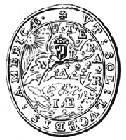ROADS IN SOMERSET COUNTY, 1666-1765
by Pat Melville
Appearing in the previous issue of the Bulldog was
an article about the legal requirements concerning roads
in Maryland. Beginning in this issue and several to follow
will be articles about how the county justices implemented
the laws, as shown in extant records.
(Judicial Record) in series C1774 of the Somerset County
Court contains the minutes of the justices. The first nine
volumes, 1665-1692, are available online as
transcripts and image files through the
Archives of Maryland. These minutes plus the originals for the later years
were sampled to ascertain the types of information
available about roads under the laws passed in 1666 and
1704.
Most of the entries concerning roads were brief and
precise routes were seldom specified. The normal
description mentioned the beginning and ending points,
often with one or both being a person's plantation or
farm. The earliest extant reference to roads occurred
November 8, 1670, in regard to "high wayes at
Wiccocomoco." The justices resolved an unspecified dispute
between the overseer and the residents by ordering "a way
made for horse & foote to the point of marsh against
Mr. James Jones house."
The county court heard petitions about the establishment
of new roads and bridges and the alteration or repair of
existing ones. Road construction in the colonial period
meant clearing a path for the movement of people and
freight. As a result changing a route was relatively
simple. In 1683 James Round wanted a road moved because it
was too close to his house and a planned water mill would
flood it. The court gave him permission to alter the
course of the road and ordered John Cropper and Richard
Hill to mark the new route.
In 1689 Rev. William Traill was preparing to clear land
on a plantation along the Pocomoke, but was
|





